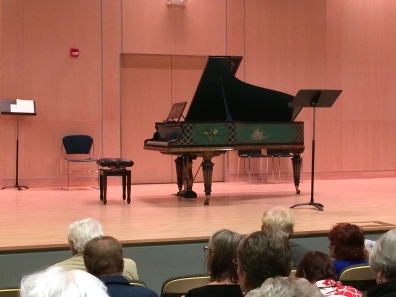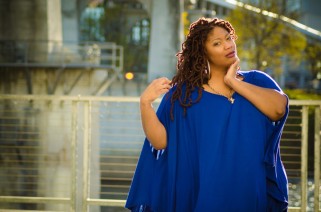World premiere of Paul Moravec’s opera promises future success
By Peter Alexander
The Saturday (May 7) premiere of The Shining by Paul Moravec at the Minnesota Opera was clear evidence of the vigor of contemporary opera in America.

The Shining by Paul Moravec. All photos by Ken Howard for the Minnesota Opera
The opera, based on the Stephen King novel (but resolutely not on the Stanley Kubrick film), has sold out its opening run of four performances. It is a solid piece of work, dramatically effective, musically successful, and destined to be popular. And in the hands of the team from the Minnesota Opera—conductor Michael Christie, stage director Eric Simonson, scenery and properties designer Erhard Rom, the craftsmen of 59 Productions and their many colleagues—The Shining received a stunning production that realized the full potential of the score. The cast was uniformly first rate. At the end, the sold-out Ordway Music Theater audience stood and cheered.

Brian Mulligan as Jack Torrance, with the massive boiler
If you don’t know the story, Jack Torrance, a writer, has taken a job as winter caretaker of the isolated Overlook Hotel (loosely inspired by Estes Park’s Stanley Hotel), a seemingly elegant relic that turns out to be haunted. Jack brings his wife, Wendy, and young son, Danny, with him. Jack and Wendy are hoping to restore their damaged marriage, but under the sway of the hotel and its ghosts, the already fragile Jack turns violent.
Librettist Mark Campbell has done an effective job of reducing King’s 400+ page novel into a two-hour opera. The essential elements of King’s tale are present: the evil spirits that control the hotel, the temperamental boiler that threatens to blow the place to bits, the smothering snow that creates a barrier from rescue, the child with second sight (or the “shining” of the work’s title), and his hair-triggered father’s troubling past. It’s a lot to get into a compact libretto, but Campbell has managed to keep the spirit of the original while necessarily cutting some elements (including several of the haunted rooms, the topiary animals standing guard and the malevolent wasps).

Alejandro Vega as Danny and Brian Mulligan as Jack
There is one significant change that King’s fans will notice, and it is not an improvement. At the end of the novel, Danny confronts his father fearlessly, because he knows something that Jack has forgotten: the boiler, which is close to blowing. When Danny reminds him of this, Jack rushes to the basement, leaving only enough time for the three survivors to escape. In other words, the Overlook has completely taken over Jack, who becomes a tragic figure brought down by his own weakness.

Brian Mulligan as Jack, surrounded by evil spirits just before the boiler destroys the Overlook Hotel
In the opera, Jack allows Danny to go, and when the hotel’s spirits remind him of the boiler, he defies them and decides not to relieve the built-up pressure so that his family can escape. When he chooses to die in the resultant explosion, the story becomes a more conventional one of Jack’s redemption, a point made clear in the staging. In King’s bleaker vision, there is no such redemption.
Moravec has set this tale with accessible, expressive music. The text can be clearly understood, thanks to both composer and cast, and supertitles are often not needed. There are moments of affecting lyrical beauty, particularly the moving (if predictable) final aria by Halloran, the resort’s cook and the story’s rescuer, who reassures Danny that “You’re doing fine by yourself . . . Just fine.” Other major characters—Jack, Wendy, and the spectral figure of Jack’s brutal father—all have expressive music. If the ghostly chorus of evil spirits sounds a little too real, that is a consequence of portraying incorporeal beings with corporeal actors.

The exploding Overlook Hotel
The horror genre is of course a well worked musical field, through opera and especially film. It is probably inevitable that Moravec incorporated some familiar clichés to represent menace, the sinister noises of malevolent spirits, ghostly voices and the ratcheting up of suspense, but it is a testament to his skill as a composer that these clichés are elevated by his score.
The orchestral writing is especially outstanding. The orchestra supports but never obscures the vocal lines. Sounds from the orchestra fit the text and mood, and the final powerful cataclysm is one of the most effective moments of musical pictorialism I can recall. That orchestral explosion and the subsequent relaxation into the comfortable and comforting music of the final scene make a satisfying ending.

Kelly Kaduce, Arthur Woodley and Alejandro Vega in the final scene
Minnesota Opera’s production is a dazzling tour de force. The beautiful projections that place the actors on a mountain road and beside a peaceful lake are impressive enough, but even more impressive are the scenes in the hotel, with a combination of atmospheric projections that heighten the mood and sliding units that shift (almost) seamlessly from room to room, with only the occasional “thump” to remind us of the stage machinery. Kudos to the designers and 59 Productions for the magic. The hulking boiler and its spectacular destruction of the hotel deserve special notice.
Of the singers, Arthur Woodley is magisterial as Halloran. The hearty cheers he received were well deserved: his robust baritone filled the hall and captured the brief scenes where he appears, at beginning and end.

Brian Mulligan as Jack and Kelly Kaduce as Wendy
As Jack, Brian Mulligan added physical menace to a steel-cored voice. If his rapid swings early in the opera between loving family man and brutal tyrant seemed too precipitous, they were indeed frightening, as they should be. His deterioration in the second act was especially effective, as the Overlook asserts control and less and less of Jack is left. The power of the performance comes from growing intensity of his interpretation rather than any specific musical numbers along the way.
Kelly Kaduce, who sang Wendy Torrance, is deservedly a Minnesota Opera favorite. She sang with expression and beauty of sound, but her role stays long in a limited emotional range, mostly expressing fear of her husband and comfort for her son. Her aria at the beginning, “I never stopped loving you” helps suggest a warmer relationship with Jack, but in that one moment the music doesn’t quite rise to the needs of the text.
It would be remiss not to observe that the teasing and sexy moments between Jack and Wendy are well written, and that both text and actors captured well the mood of King’s novel. In the pared down, two-hour stage presentation they seem too ephemeral, as if squeezed in for relief; expansion of those moments, musically or dramatically, could restore the balance found in the novel’s more thorough back story.

Alejandro Vega (Danny) and Arthur Woodley (Halloran)
Alejandro Vega, the 10-year-old who brings Danny movingly to life, shows great talent. His assurance and the authenticity of his emotional reactions to the story reveal a natural actor, but also one who is skillfully trained and directed in the role. He was on stage for much of the performance, and he was fully the equal of the adults with whom he shared the stage. For later productions this will be a make-or-break role. Vega definitely made it.
Minnesota Opera has put together an able ensemble cast for the other roles as well. Mark Walters as Jack’s father who reaches from beyond the grave to drive his son toward murder; David Walton as the seductive former caretaker and multi-murderer Delbert Grady; Robb Asklof as haughty hotel manager Stuart Ullman; Alex Ritchie as the hotel’s depraved founder Horace Derwent: all were scarily effective.

Wendy, Danny and Jack surrounded by ghosts and ghouls
Christie led the Minnesota Opera’s excellent orchestra with care and sensitivity to the singers. I could not find a serious flaw in the balance, and—considering I had not heard the piece before—the pacing seemed just right. We in Boulder, and now audiences in Minnesota, know that his is an important career.
I have no doubt that The Shining will go on to other productions, especially in the United States where Stephen King’s works loom so large in the popular culture. Many more audiences will stand and cheer.
# # # # #
Minnesota Opera has become one of the most ardent and consistent supporters of new opera in the country. When you consider the record of some of the financially larger companies, their record of world premieres in four of the last five seasons (Kevin Puts, Silent Night, 2011; Douglas J. Cuomo, Doubt, 2013; Kevin Puts, Manchurian Candidate, 2015; and Paul Moravec, The Shining, 2016) puts them in a league with the adventurous Santa Fe Opera and few other professional companies.
And they have announced another premiere next season, Dinner at Eight by William Bolcom, based on the play by George S. Kaufman and Edna Ferber (March 11, 16, 18 and 19, 2017; you may see the entire, enticing season here.) I find it particularly exciting that our own American culture is being mined for operatic subjects, much as European opera has mined their shared culture for generations. This is certainly one of the reasons that contemporary opera is growing in popularity. There is more evidence than The Shining of American opera’s vigor today.








































